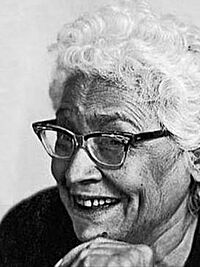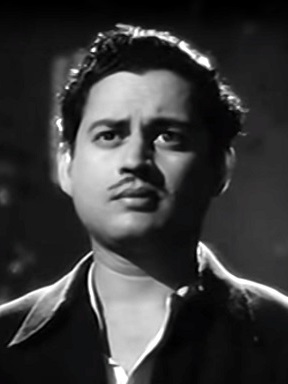Ismat Chughtai facts for kids
Quick facts for kids
Ismat Chughtai
|
|
|---|---|
 |
|
| Born | 21 August 1915 Budaun, United Provinces, British India |
| Died | 24 October 1991 (aged 76) Mumbai, Maharashtra, India |
| Occupation |
|
| Language | Urdu |
| Nationality | Indian |
| Alma mater | Aligarh Muslim University |
| Genre |
|
| Notable works | Works of Ismat Chughtai |
| Children | Seema Sawhny Sabrina Lateef |
Ismat Chughtai (born August 21, 1915 – died October 24, 1991) was an important Indian writer. She wrote novels and short stories in Urdu language. She was also a filmmaker.
Starting in the 1930s, Ismat wrote about many topics. These included the lives of women and challenges faced by different social classes. She often wrote in a very realistic style. Ismat Chughtai became a major voice in Urdu literature. In 1976, she received the Padma Shri award from the Government of India. This is a high honor for Indian citizens.
Contents
About Ismat Chughtai
Her Early Life and First Writings (1915–1941)
Ismat Chughtai was born on August 21, 1915. Her birthplace was Badayun, in Uttar Pradesh, India. She was the ninth of ten children in her family. Her father worked for the government. Because of his job, her family moved often. Ismat spent her childhood in cities like Jodhpur, Agra, and Aligarh.
She spent most of her time with her brothers. Her older sisters had married when Ismat was very young. Ismat said her brothers greatly influenced her personality. Her second-oldest brother, Mirza Azim Beg Chughtai, was also a writer. She looked up to him as a mentor.
Ismat went to the Women's College, Aligarh for her early education. She earned a Bachelor of Arts degree in 1940. The next year, she got a Bachelor of Education degree. Her family did not want her to study so much. But she completed her studies anyway.
During this time, Ismat joined the Progressive Writers' Association. She met Rashid Jahan, a leading female writer. Rashid Jahan inspired Ismat to write about "realistic, challenging female characters." Ismat started writing privately. She did not try to publish her work until later.
Her first published work was a play called Fasādī (The Troublemaker). It appeared in an Urdu magazine in 1939. At first, readers thought her brother wrote it. After that, she wrote for other magazines and newspapers. Some of her early works included Bachpan (Childhood), an autobiography. She also wrote Kafir (Infidel), her first short story. Another work was Dheet (Stubborn), a unique solo speech. Some people found her early work controversial. But she kept writing about "things she would hear of."
Ismat's connection with the Progressive Writers' Movement shaped her writing. She was especially interested in Angarey. This was a collection of Urdu short stories by members of the group. Other writers who influenced her included William Sydney Porter, George Bernard Shaw, and Anton Chekhov. Her first collections of short stories were Kalyān (Buds) and Cōtēn (Wounds). They were published in 1941 and 1942.
Ismat's first short novel, Ziddi, came out in 1941. She wrote it in her early twenties. The book tells the story of a love affair. It is about a woman who works in a rich house and her employer's son. Critics praised the novel for its "compelling prose." They also liked how it showed women trying to break free from old rules. Ziddi was later made into a film in 1948.
Becoming Famous and Working in Film (1942–1960)
After finishing her education, Ismat became a headmistress at a girls' school in Aligarh. There, she met Shaheed Latif. He was studying at Aligarh Muslim University. They became close friends. Ismat continued to write for various publications. She wrote popular short stories like Gainda and Khidmatgaar. She also wrote the play Intikhab.
In 1942, she moved to Bombay. She started working as an Inspectress of schools. Later that year, she married Latif. He was working as a dialogue writer in Bollywood. Khwaja Ahmad Abbas was a witness at their wedding.
Ismat became widely known for her short story Lihaaf (The Quilt). It was published in a literary journal in 1942. This story brought her a lot of attention. It was about a lonely woman's life in a traditional society.
Her novel Tedhi Lakeer (The Crooked Line) was released in 1943. This book was partly based on her own life. She wrote it while she was pregnant with her daughter. She said she found inspiration from small events and conversations around her. The book explores the lives of Muslim women during the end of the British Raj. Critics praised her for looking deeply into "the inner realms of women's lives." They called her work "probing and empowering."
Latif introduced Ismat to the Hindi film industry. She started writing movie scripts in the late 1940s. Her first film as a screenwriter was Latif's drama Ziddi (1948). This film was a big success. She then wrote dialogue and screenplays for other films. These included Arzoo (1950). Ismat also started directing films. She co-directed Fareb (1953) with Latif. Both Arzoo and Fareb were popular with audiences.
Ismat and Latif started their own film company called Filmina. Her first project as a filmmaker was Sone Ki Chidiya (1958). She wrote and co-produced this drama. The film told the story of a child actor who was treated badly. This movie was well-received. It helped Ismat become even more popular. Sone Ki Chidiya is important because it showed the difficult side of the film industry. In 1958, Ismat also produced the romance drama Lala Rukh.
Even with her film work, Ismat continued writing short stories. Her fourth collection, Chui Mui (Touch-me-not), came out in 1952. The main story in this collection was praised for looking at society. It questioned traditional ideas about motherhood and womanhood. This story was later adapted for the stage.
Writing More Novels (1961–1990)
From the 1960s, Ismat wrote eight novels. The first was Masooma (The Innocent Girl), published in 1962. This novel explored themes of social and economic injustice. Her next work, Saudai (Obsession), was based on a film screenplay she co-wrote.
After these, Ismat received great praise for her fifth novel, Dil ki Duniya (The Heart Breaks Free). Many critics consider it one of her best works. The novel follows the lives of different women in a traditional Muslim home. Dil Ki Duniya is also based on Ismat's own childhood experiences.

In the early 1970s, Ismat wrote two novels. These were Ajeeb Aadmi (A Very Strange Man) and Jangli Kabootar (Wild Pigeons). She used her knowledge of the Hindi film industry for these books. Jangli Kabootar (1970) tells the story of an actress. It was inspired by a real event. Ismat's grandson, Aijaz Khan, wants to make a film based on this story.
Ajeeb Aadmi is about a popular leading actor in Bollywood. Ismat said she explored why people were drawn to such actors. The novel was praised for being bold and honest. A journalist named Jerry Pinto said it was the most dramatic and honest account of Bollywood's emotional lives. Khalid Mohamed called it a unique "tell-all" book about the film industry. He noted Ismat's "instinctive gift for relating stories frankly and fearlessly."
Later Years and Recognition (1990s and Beyond)
Ismat Chughtai was diagnosed with Alzheimer's disease in the late 1980s. This limited her ability to work. She passed away at her home in Mumbai on October 24, 1991.
After her death, many of her works were translated into English. This led to new interest in Urdu literature. Critics began to re-examine her writings. Her status as a writer grew. Lihaaf became even more important. It was recognized for showing the isolated life of a neglected wife. This story is now widely read and appreciated.
As more of her work became available, people realized her writing was very broad. Critics noted that her work was not limited to just a few themes. She continued to explore new ideas and expand her writing.
Tedhi Lakeer is now considered her greatest work. It is seen as one of the most important works in Urdu literature. Critics have praised its high quality. They say Ismat combined her literary influences and her own experiences to create a powerful book. The novel explores issues of nationalism and women's rights. Some have compared her writing style to that of French writer Simone de Beauvoir.
Her Influences and Writing Style
Ismat Chughtai was a liberal Muslim. Her family included Hindus, Muslims, and Christians who lived peacefully. She said she read not only the Qur’an, but also the Gita and the Bible.
Ismat's short stories showed the culture of the region where she lived. For example, her story "Sacred Duty" dealt with social pressures in India. It touched on specific national, religious, and cultural traditions.
Early in her career, writers like Nazar Sajjad Hyder, Hijab Imtiaz Ali, and Rashid Jehan influenced her. They were independent female voices.
Many of her writings, including Angarey and Lihaaf, were not allowed in South Asia for a time. This was because her ideas challenged old traditions. For example, she believed the Niqab (the veil worn by some Muslim women) should not be encouraged. She felt it was unfair and old-fashioned.
Tribute
On August 21, 2018, Google celebrated Ismat Chughtai's 107th birthday with a special Google Doodle.
Film Work
| Year | Title | Role | Notes |
|---|---|---|---|
| 1948 | Shikayat | – | Dialogue writer |
| 1948 | Ziddi | – | |
| 1950 | Arzoo | – | |
| 1951 | Buzdil | – | |
| 1952 | Sheesha | – | |
| 1953 | Fareb | – | Also co-director |
| 1954 | Darwaza | – | |
| 1955 | Society | – | |
| 1958 | Sone Ki Chidiya | – | Also producer |
| 1958 | Lala Rukh | – | Also co-director and producer |
| 1966 | Baharen Phir Bhi Ayengi | – | |
| 1973 | Garam Hawa | – | Filmfare Best Story Award (shared with Kaifi Azmi) |
| 1978 | Junoon | Miriam Labadoor | Cameo appearance |
Awards and Honors
| Year | Work | Award | Category | Result | Ref. |
|---|---|---|---|---|---|
| 1974 | Terhi Lakeer | Ghalib Award | Best Urdu Drama | Won | |
| 1974–75 | Garam Hawa | National Film Awards | Best Story | Won | |
| Filmfare Award | Best Story | Won | |||
| – | Government of India State Award | – | Won | ||
| 1976 | – | Indian civilian awards | Padma Shri | Won | |
| 1979 | – | Andhra Pradesh Urdu Akademi Award | Makhdoom Literary Award | Won | |
| 1982 | – | Soviet Land Nehru Award | – | Won | |
| 1990 | – | Rajasthan Urdu Akademi | Iqbal Samman | Won |
See Also
- List of Indian writers

